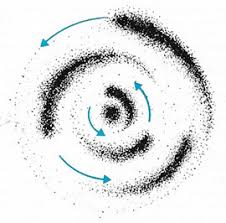The nebular hypothesis of Laplace is a scientific theory that explains the formation of the solar system. It was first proposed by the French mathematician and astronomer, Pierre-Simon Laplace, in 1796.

Table of Contents
Explanation of the Nebular Hypothesis
According to this theory, the solar system is formed from a rotating cloud of gas and dust known as the solar nebula. The solar nebula theory suggests that the solar system began as a giant cloud of gas and dust. This cloud was formed from the remnants of an earlier star that exploded in a supernova. The cloud was losing the heat and contracting and started to spin faster and faster, flattening out into a disk-like shape due to centrifugal force. The center of the disk became the sun, while the rest of the disk eventually formed the planets, moons, asteroids, and comets of the solar system.
Formation of the Planets
According to the nebular hypothesis of Laplace, the solar nebula was initially a homogeneous, isotropic, and gaseous cloud. As the cloud contracted, it heated up and started to emit radiation. This radiation caused the gas to cool down and form solid particles, which eventually grew into planetesimals. These planetesimals continued to collide and merge with each other, eventually forming the planets.
Characteristics of the Planets
The nebular hypothesis of Laplace also explains the different characteristics of the planets in the solar system. The inner planets, Mercury, Venus, Earth, and Mars, are small and rocky because they formed close to the sun where the temperatures were high, and only solid materials could condense. The outer planets, Jupiter, Saturn, Uranus, and Neptune, are much larger and made mostly of gas and ice because they formed farther away from the sun where temperatures were colder, and volatile materials could also condense.
Limitations of the Nebular Hypothesis
However, the nebular hypothesis of Laplace has some limitations. For instance, it cannot explain the formation of the Kuiper Belt, a region beyond the orbit of Neptune that contains small icy bodies, including Pluto. It also cannot explain the existence of irregular moons, which have orbits that are not aligned with their planet’s equator.
Conclusion
In conclusion, the nebular hypothesis of Laplace is a scientific theory that explains the formation of the solar system from a rotating cloud of gas and dust. It provides a comprehensive explanation for the different characteristics of the planets in the solar system. While the theory has some limitations, it remains a widely accepted explanation for the origin of our solar system.
Important Links